Anaemia: Global Health Problem with National Strategies
VerifiedAdded on 2022/11/17
|7
|1981
|212
Report
AI Summary
This report provides a detailed overview of anaemia, a significant public health challenge affecting both developed and developing countries. It begins by defining anaemia and its impact on human health and socio-economic development, emphasizing iron deficiency anaemia (IDA) as a primary cause. The report explores the determinants of anaemia, distinguishing between immediate and upstream factors, including dietary iron intake and socio-economic conditions. It then delves into the aetiology, epidemiology, and risk groups, highlighting the global prevalence, particularly among women and children. The report further examines national strategies to combat anaemia, focusing on the Anaemia Mukt Bharat initiative in India, outlining key interventions such as iron and folic acid supplementation, deworming programs, and behavior change communication. Additionally, it discusses Bangladesh's national strategy for anaemia prevention, emphasizing the importance of micronutrient supplementation, food fortification, and household food production. The report concludes by underscoring the multi-faceted approach required to address this global health issue effectively.
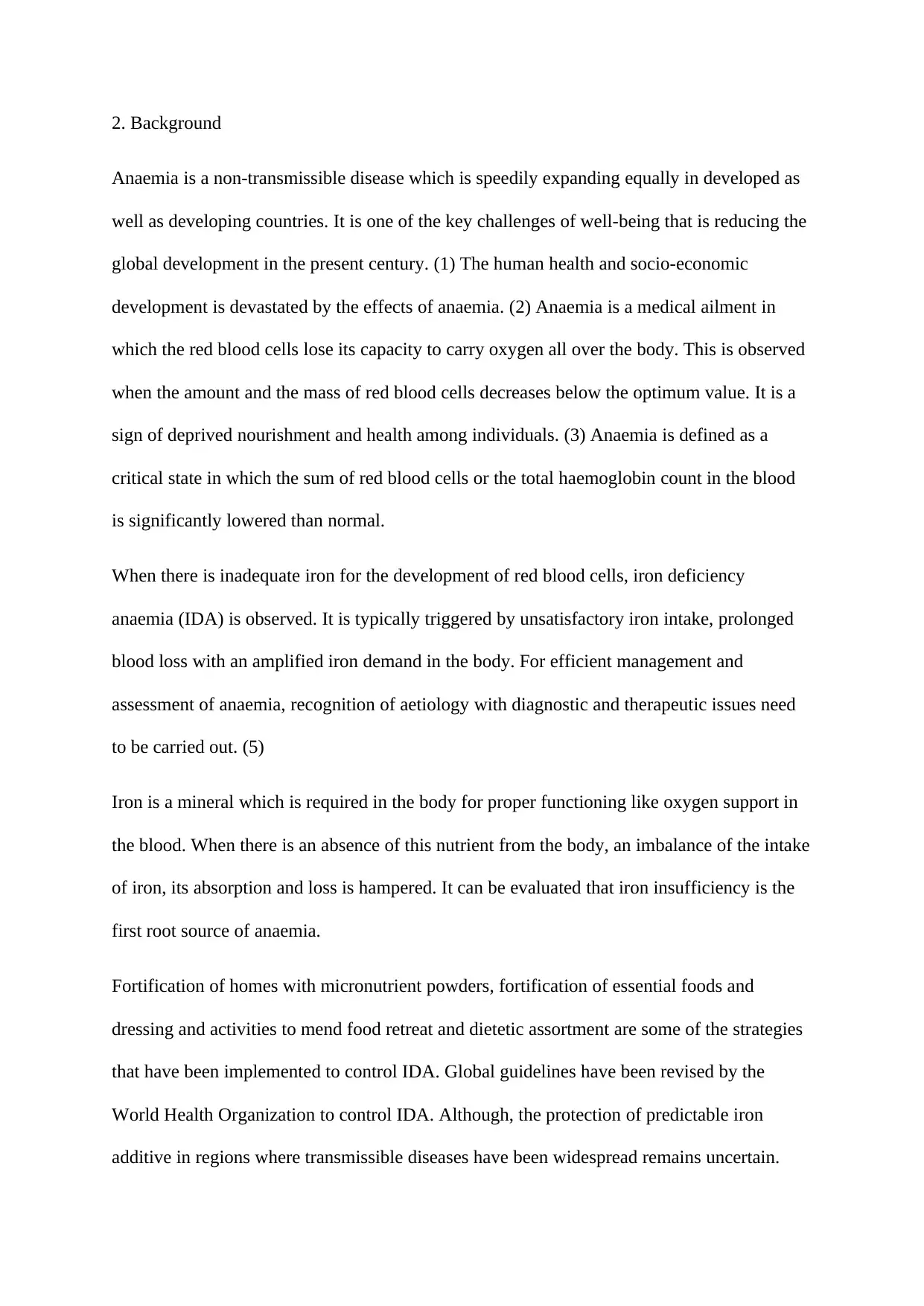
2. Background
Anaemia is a non-transmissible disease which is speedily expanding equally in developed as
well as developing countries. It is one of the key challenges of well-being that is reducing the
global development in the present century. (1) The human health and socio-economic
development is devastated by the effects of anaemia. (2) Anaemia is a medical ailment in
which the red blood cells lose its capacity to carry oxygen all over the body. This is observed
when the amount and the mass of red blood cells decreases below the optimum value. It is a
sign of deprived nourishment and health among individuals. (3) Anaemia is defined as a
critical state in which the sum of red blood cells or the total haemoglobin count in the blood
is significantly lowered than normal.
When there is inadequate iron for the development of red blood cells, iron deficiency
anaemia (IDA) is observed. It is typically triggered by unsatisfactory iron intake, prolonged
blood loss with an amplified iron demand in the body. For efficient management and
assessment of anaemia, recognition of aetiology with diagnostic and therapeutic issues need
to be carried out. (5)
Iron is a mineral which is required in the body for proper functioning like oxygen support in
the blood. When there is an absence of this nutrient from the body, an imbalance of the intake
of iron, its absorption and loss is hampered. It can be evaluated that iron insufficiency is the
first root source of anaemia.
Fortification of homes with micronutrient powders, fortification of essential foods and
dressing and activities to mend food retreat and dietetic assortment are some of the strategies
that have been implemented to control IDA. Global guidelines have been revised by the
World Health Organization to control IDA. Although, the protection of predictable iron
additive in regions where transmissible diseases have been widespread remains uncertain.
Anaemia is a non-transmissible disease which is speedily expanding equally in developed as
well as developing countries. It is one of the key challenges of well-being that is reducing the
global development in the present century. (1) The human health and socio-economic
development is devastated by the effects of anaemia. (2) Anaemia is a medical ailment in
which the red blood cells lose its capacity to carry oxygen all over the body. This is observed
when the amount and the mass of red blood cells decreases below the optimum value. It is a
sign of deprived nourishment and health among individuals. (3) Anaemia is defined as a
critical state in which the sum of red blood cells or the total haemoglobin count in the blood
is significantly lowered than normal.
When there is inadequate iron for the development of red blood cells, iron deficiency
anaemia (IDA) is observed. It is typically triggered by unsatisfactory iron intake, prolonged
blood loss with an amplified iron demand in the body. For efficient management and
assessment of anaemia, recognition of aetiology with diagnostic and therapeutic issues need
to be carried out. (5)
Iron is a mineral which is required in the body for proper functioning like oxygen support in
the blood. When there is an absence of this nutrient from the body, an imbalance of the intake
of iron, its absorption and loss is hampered. It can be evaluated that iron insufficiency is the
first root source of anaemia.
Fortification of homes with micronutrient powders, fortification of essential foods and
dressing and activities to mend food retreat and dietetic assortment are some of the strategies
that have been implemented to control IDA. Global guidelines have been revised by the
World Health Organization to control IDA. Although, the protection of predictable iron
additive in regions where transmissible diseases have been widespread remains uncertain.
Paraphrase This Document
Need a fresh take? Get an instant paraphrase of this document with our AI Paraphraser
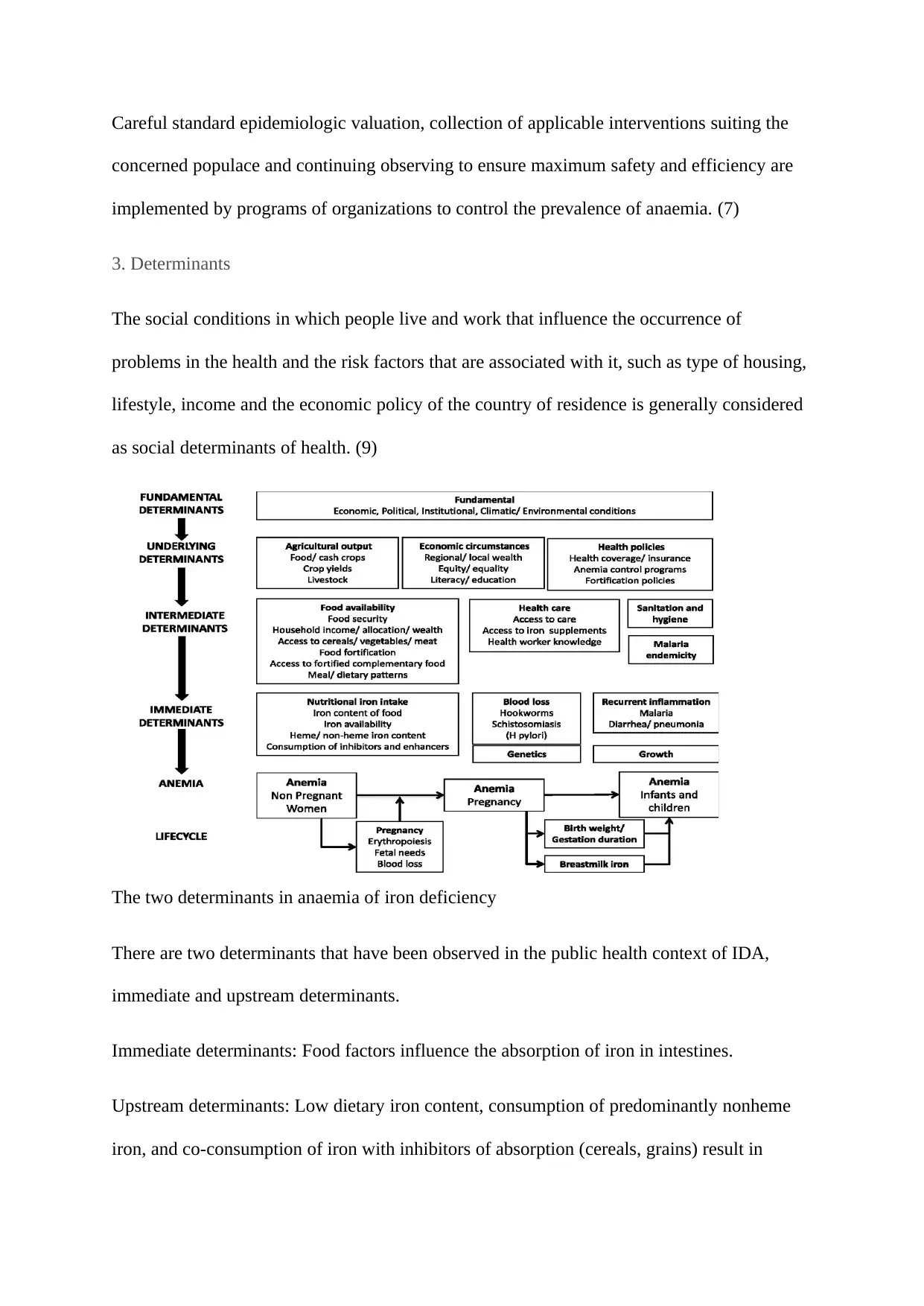
Careful standard epidemiologic valuation, collection of applicable interventions suiting the
concerned populace and continuing observing to ensure maximum safety and efficiency are
implemented by programs of organizations to control the prevalence of anaemia. (7)
3. Determinants
The social conditions in which people live and work that influence the occurrence of
problems in the health and the risk factors that are associated with it, such as type of housing,
lifestyle, income and the economic policy of the country of residence is generally considered
as social determinants of health. (9)
The two determinants in anaemia of iron deficiency
There are two determinants that have been observed in the public health context of IDA,
immediate and upstream determinants.
Immediate determinants: Food factors influence the absorption of iron in intestines.
Upstream determinants: Low dietary iron content, consumption of predominantly nonheme
iron, and co-consumption of iron with inhibitors of absorption (cereals, grains) result in
concerned populace and continuing observing to ensure maximum safety and efficiency are
implemented by programs of organizations to control the prevalence of anaemia. (7)
3. Determinants
The social conditions in which people live and work that influence the occurrence of
problems in the health and the risk factors that are associated with it, such as type of housing,
lifestyle, income and the economic policy of the country of residence is generally considered
as social determinants of health. (9)
The two determinants in anaemia of iron deficiency
There are two determinants that have been observed in the public health context of IDA,
immediate and upstream determinants.
Immediate determinants: Food factors influence the absorption of iron in intestines.
Upstream determinants: Low dietary iron content, consumption of predominantly nonheme
iron, and co-consumption of iron with inhibitors of absorption (cereals, grains) result in
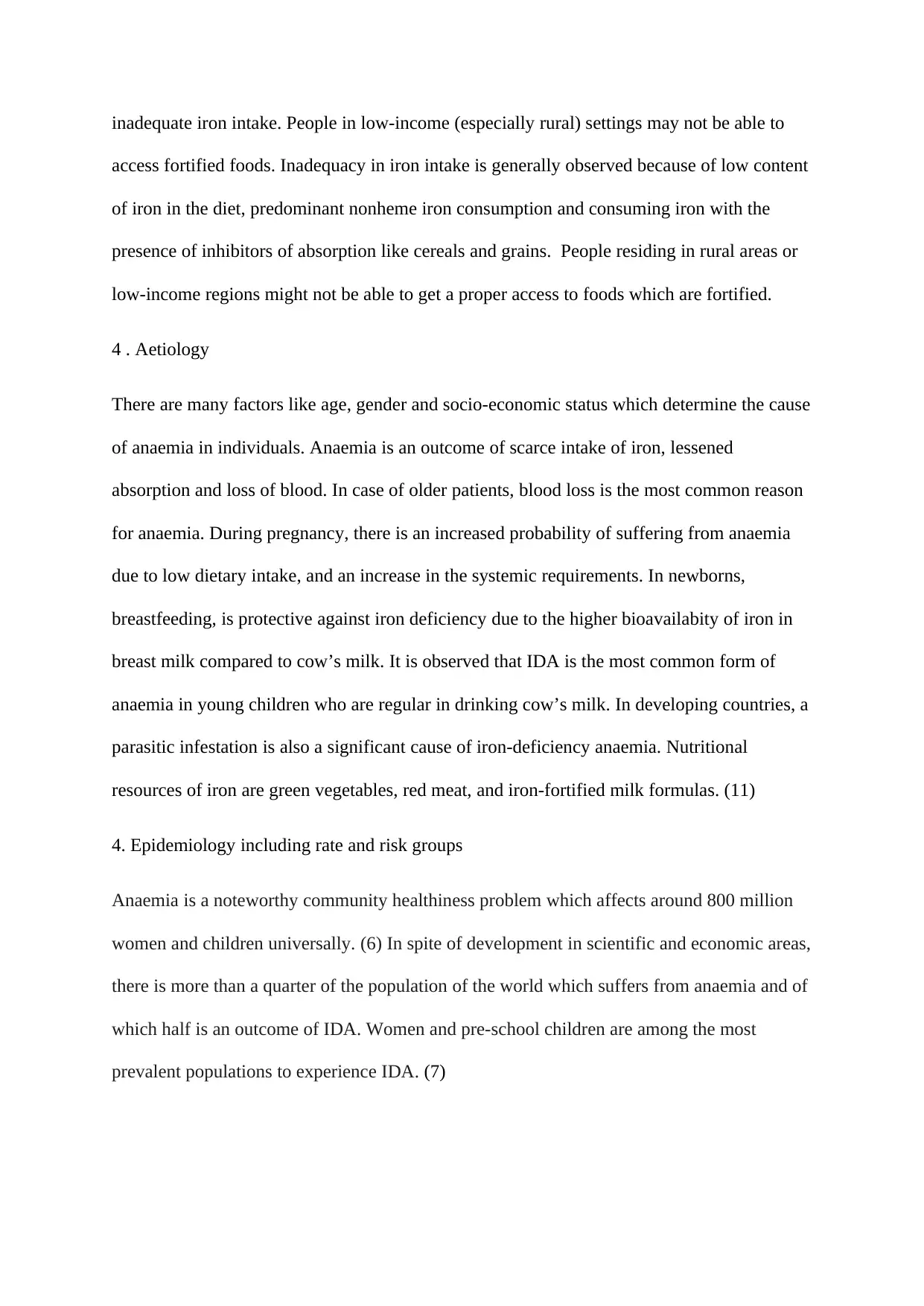
inadequate iron intake. People in low-income (especially rural) settings may not be able to
access fortified foods. Inadequacy in iron intake is generally observed because of low content
of iron in the diet, predominant nonheme iron consumption and consuming iron with the
presence of inhibitors of absorption like cereals and grains. People residing in rural areas or
low-income regions might not be able to get a proper access to foods which are fortified.
4 . Aetiology
There are many factors like age, gender and socio-economic status which determine the cause
of anaemia in individuals. Anaemia is an outcome of scarce intake of iron, lessened
absorption and loss of blood. In case of older patients, blood loss is the most common reason
for anaemia. During pregnancy, there is an increased probability of suffering from anaemia
due to low dietary intake, and an increase in the systemic requirements. In newborns,
breastfeeding, is protective against iron deficiency due to the higher bioavailabity of iron in
breast milk compared to cow’s milk. It is observed that IDA is the most common form of
anaemia in young children who are regular in drinking cow’s milk. In developing countries, a
parasitic infestation is also a significant cause of iron-deficiency anaemia. Nutritional
resources of iron are green vegetables, red meat, and iron-fortified milk formulas. (11)
4. Epidemiology including rate and risk groups
Anaemia is a noteworthy community healthiness problem which affects around 800 million
women and children universally. (6) In spite of development in scientific and economic areas,
there is more than a quarter of the population of the world which suffers from anaemia and of
which half is an outcome of IDA. Women and pre-school children are among the most
prevalent populations to experience IDA. (7)
access fortified foods. Inadequacy in iron intake is generally observed because of low content
of iron in the diet, predominant nonheme iron consumption and consuming iron with the
presence of inhibitors of absorption like cereals and grains. People residing in rural areas or
low-income regions might not be able to get a proper access to foods which are fortified.
4 . Aetiology
There are many factors like age, gender and socio-economic status which determine the cause
of anaemia in individuals. Anaemia is an outcome of scarce intake of iron, lessened
absorption and loss of blood. In case of older patients, blood loss is the most common reason
for anaemia. During pregnancy, there is an increased probability of suffering from anaemia
due to low dietary intake, and an increase in the systemic requirements. In newborns,
breastfeeding, is protective against iron deficiency due to the higher bioavailabity of iron in
breast milk compared to cow’s milk. It is observed that IDA is the most common form of
anaemia in young children who are regular in drinking cow’s milk. In developing countries, a
parasitic infestation is also a significant cause of iron-deficiency anaemia. Nutritional
resources of iron are green vegetables, red meat, and iron-fortified milk formulas. (11)
4. Epidemiology including rate and risk groups
Anaemia is a noteworthy community healthiness problem which affects around 800 million
women and children universally. (6) In spite of development in scientific and economic areas,
there is more than a quarter of the population of the world which suffers from anaemia and of
which half is an outcome of IDA. Women and pre-school children are among the most
prevalent populations to experience IDA. (7)
⊘ This is a preview!⊘
Do you want full access?
Subscribe today to unlock all pages.

Trusted by 1+ million students worldwide
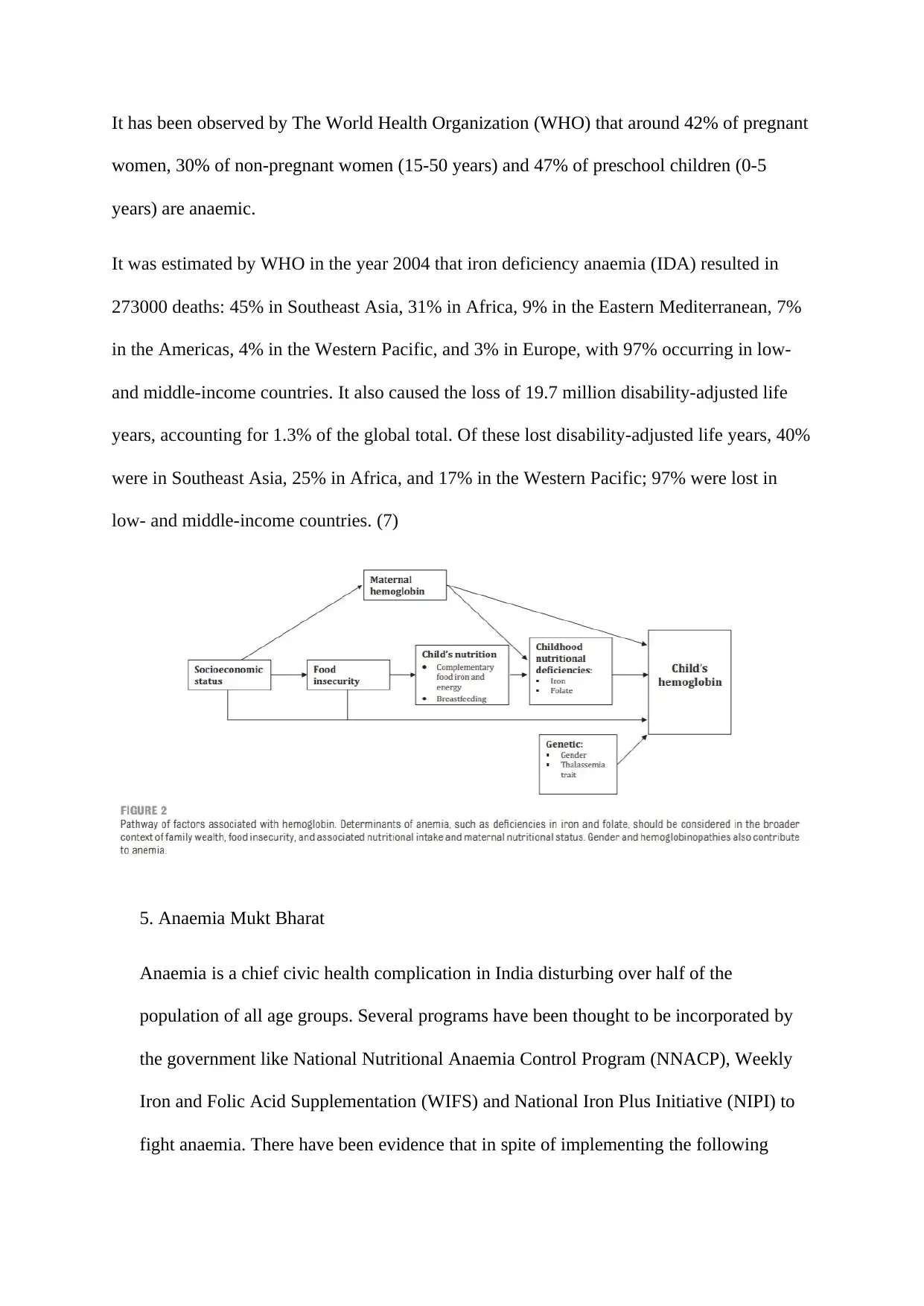
It has been observed by The World Health Organization (WHO) that around 42% of pregnant
women, 30% of non-pregnant women (15-50 years) and 47% of preschool children (0-5
years) are anaemic.
It was estimated by WHO in the year 2004 that iron deficiency anaemia (IDA) resulted in
273000 deaths: 45% in Southeast Asia, 31% in Africa, 9% in the Eastern Mediterranean, 7%
in the Americas, 4% in the Western Pacific, and 3% in Europe, with 97% occurring in low-
and middle-income countries. It also caused the loss of 19.7 million disability-adjusted life
years, accounting for 1.3% of the global total. Of these lost disability-adjusted life years, 40%
were in Southeast Asia, 25% in Africa, and 17% in the Western Pacific; 97% were lost in
low- and middle-income countries. (7)
5. Anaemia Mukt Bharat
Anaemia is a chief civic health complication in India disturbing over half of the
population of all age groups. Several programs have been thought to be incorporated by
the government like National Nutritional Anaemia Control Program (NNACP), Weekly
Iron and Folic Acid Supplementation (WIFS) and National Iron Plus Initiative (NIPI) to
fight anaemia. There have been evidence that in spite of implementing the following
women, 30% of non-pregnant women (15-50 years) and 47% of preschool children (0-5
years) are anaemic.
It was estimated by WHO in the year 2004 that iron deficiency anaemia (IDA) resulted in
273000 deaths: 45% in Southeast Asia, 31% in Africa, 9% in the Eastern Mediterranean, 7%
in the Americas, 4% in the Western Pacific, and 3% in Europe, with 97% occurring in low-
and middle-income countries. It also caused the loss of 19.7 million disability-adjusted life
years, accounting for 1.3% of the global total. Of these lost disability-adjusted life years, 40%
were in Southeast Asia, 25% in Africa, and 17% in the Western Pacific; 97% were lost in
low- and middle-income countries. (7)
5. Anaemia Mukt Bharat
Anaemia is a chief civic health complication in India disturbing over half of the
population of all age groups. Several programs have been thought to be incorporated by
the government like National Nutritional Anaemia Control Program (NNACP), Weekly
Iron and Folic Acid Supplementation (WIFS) and National Iron Plus Initiative (NIPI) to
fight anaemia. There have been evidence that in spite of implementing the following
Paraphrase This Document
Need a fresh take? Get an instant paraphrase of this document with our AI Paraphraser
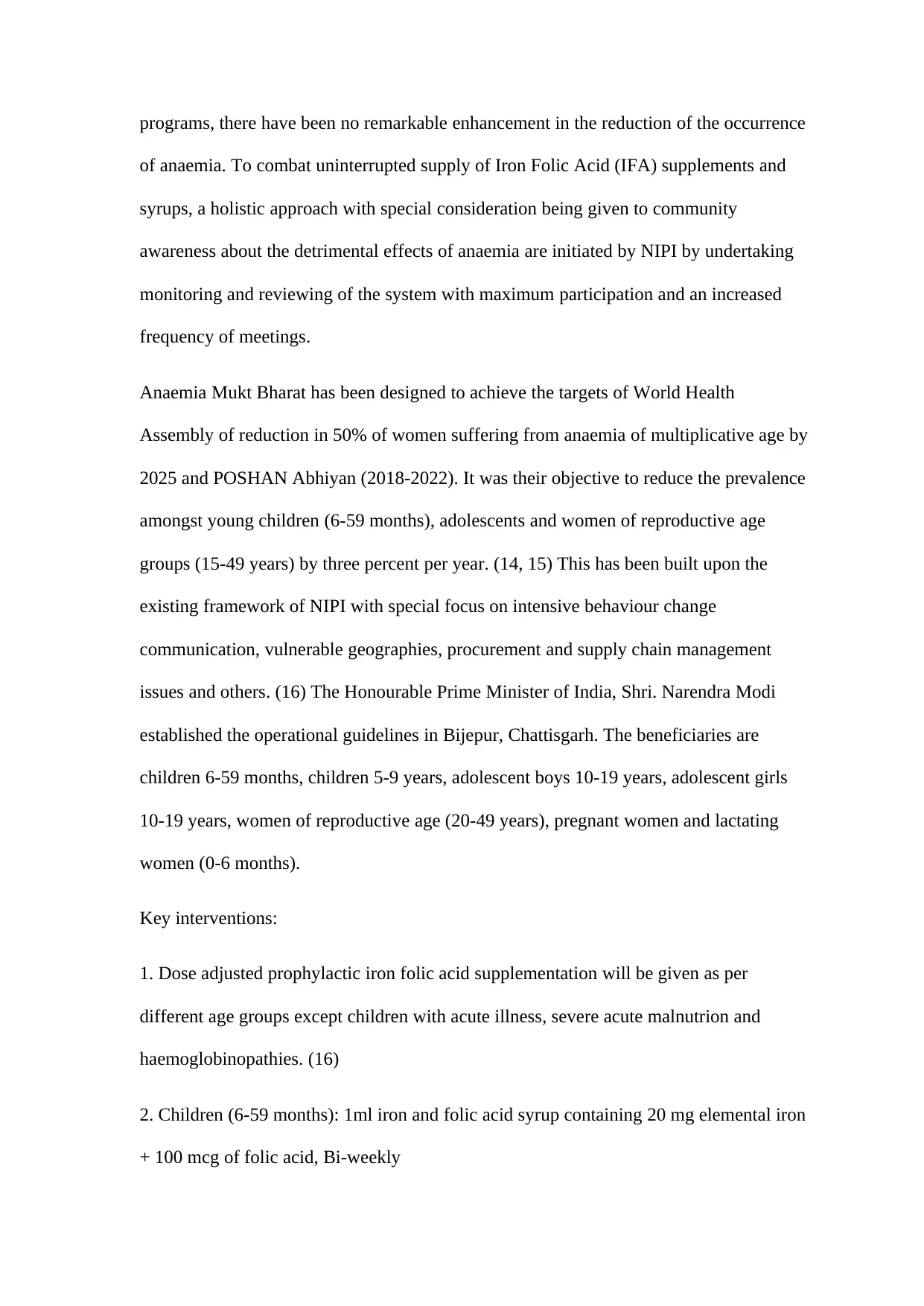
programs, there have been no remarkable enhancement in the reduction of the occurrence
of anaemia. To combat uninterrupted supply of Iron Folic Acid (IFA) supplements and
syrups, a holistic approach with special consideration being given to community
awareness about the detrimental effects of anaemia are initiated by NIPI by undertaking
monitoring and reviewing of the system with maximum participation and an increased
frequency of meetings.
Anaemia Mukt Bharat has been designed to achieve the targets of World Health
Assembly of reduction in 50% of women suffering from anaemia of multiplicative age by
2025 and POSHAN Abhiyan (2018-2022). It was their objective to reduce the prevalence
amongst young children (6-59 months), adolescents and women of reproductive age
groups (15-49 years) by three percent per year. (14, 15) This has been built upon the
existing framework of NIPI with special focus on intensive behaviour change
communication, vulnerable geographies, procurement and supply chain management
issues and others. (16) The Honourable Prime Minister of India, Shri. Narendra Modi
established the operational guidelines in Bijepur, Chattisgarh. The beneficiaries are
children 6-59 months, children 5-9 years, adolescent boys 10-19 years, adolescent girls
10-19 years, women of reproductive age (20-49 years), pregnant women and lactating
women (0-6 months).
Key interventions:
1. Dose adjusted prophylactic iron folic acid supplementation will be given as per
different age groups except children with acute illness, severe acute malnutrion and
haemoglobinopathies. (16)
2. Children (6-59 months): 1ml iron and folic acid syrup containing 20 mg elemental iron
+ 100 mcg of folic acid, Bi-weekly
of anaemia. To combat uninterrupted supply of Iron Folic Acid (IFA) supplements and
syrups, a holistic approach with special consideration being given to community
awareness about the detrimental effects of anaemia are initiated by NIPI by undertaking
monitoring and reviewing of the system with maximum participation and an increased
frequency of meetings.
Anaemia Mukt Bharat has been designed to achieve the targets of World Health
Assembly of reduction in 50% of women suffering from anaemia of multiplicative age by
2025 and POSHAN Abhiyan (2018-2022). It was their objective to reduce the prevalence
amongst young children (6-59 months), adolescents and women of reproductive age
groups (15-49 years) by three percent per year. (14, 15) This has been built upon the
existing framework of NIPI with special focus on intensive behaviour change
communication, vulnerable geographies, procurement and supply chain management
issues and others. (16) The Honourable Prime Minister of India, Shri. Narendra Modi
established the operational guidelines in Bijepur, Chattisgarh. The beneficiaries are
children 6-59 months, children 5-9 years, adolescent boys 10-19 years, adolescent girls
10-19 years, women of reproductive age (20-49 years), pregnant women and lactating
women (0-6 months).
Key interventions:
1. Dose adjusted prophylactic iron folic acid supplementation will be given as per
different age groups except children with acute illness, severe acute malnutrion and
haemoglobinopathies. (16)
2. Children (6-59 months): 1ml iron and folic acid syrup containing 20 mg elemental iron
+ 100 mcg of folic acid, Bi-weekly
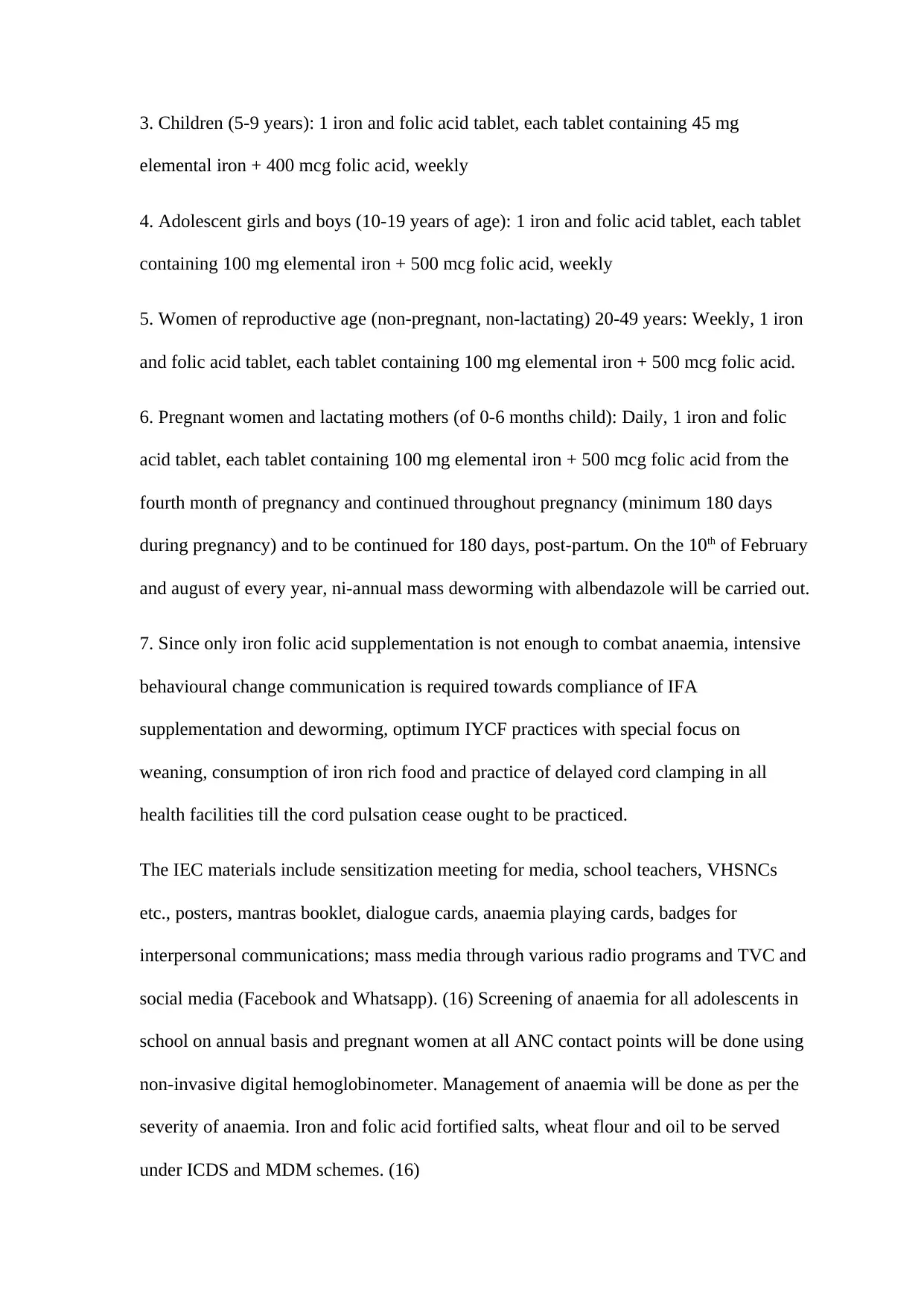
3. Children (5-9 years): 1 iron and folic acid tablet, each tablet containing 45 mg
elemental iron + 400 mcg folic acid, weekly
4. Adolescent girls and boys (10-19 years of age): 1 iron and folic acid tablet, each tablet
containing 100 mg elemental iron + 500 mcg folic acid, weekly
5. Women of reproductive age (non-pregnant, non-lactating) 20-49 years: Weekly, 1 iron
and folic acid tablet, each tablet containing 100 mg elemental iron + 500 mcg folic acid.
6. Pregnant women and lactating mothers (of 0-6 months child): Daily, 1 iron and folic
acid tablet, each tablet containing 100 mg elemental iron + 500 mcg folic acid from the
fourth month of pregnancy and continued throughout pregnancy (minimum 180 days
during pregnancy) and to be continued for 180 days, post-partum. On the 10th of February
and august of every year, ni-annual mass deworming with albendazole will be carried out.
7. Since only iron folic acid supplementation is not enough to combat anaemia, intensive
behavioural change communication is required towards compliance of IFA
supplementation and deworming, optimum IYCF practices with special focus on
weaning, consumption of iron rich food and practice of delayed cord clamping in all
health facilities till the cord pulsation cease ought to be practiced.
The IEC materials include sensitization meeting for media, school teachers, VHSNCs
etc., posters, mantras booklet, dialogue cards, anaemia playing cards, badges for
interpersonal communications; mass media through various radio programs and TVC and
social media (Facebook and Whatsapp). (16) Screening of anaemia for all adolescents in
school on annual basis and pregnant women at all ANC contact points will be done using
non-invasive digital hemoglobinometer. Management of anaemia will be done as per the
severity of anaemia. Iron and folic acid fortified salts, wheat flour and oil to be served
under ICDS and MDM schemes. (16)
elemental iron + 400 mcg folic acid, weekly
4. Adolescent girls and boys (10-19 years of age): 1 iron and folic acid tablet, each tablet
containing 100 mg elemental iron + 500 mcg folic acid, weekly
5. Women of reproductive age (non-pregnant, non-lactating) 20-49 years: Weekly, 1 iron
and folic acid tablet, each tablet containing 100 mg elemental iron + 500 mcg folic acid.
6. Pregnant women and lactating mothers (of 0-6 months child): Daily, 1 iron and folic
acid tablet, each tablet containing 100 mg elemental iron + 500 mcg folic acid from the
fourth month of pregnancy and continued throughout pregnancy (minimum 180 days
during pregnancy) and to be continued for 180 days, post-partum. On the 10th of February
and august of every year, ni-annual mass deworming with albendazole will be carried out.
7. Since only iron folic acid supplementation is not enough to combat anaemia, intensive
behavioural change communication is required towards compliance of IFA
supplementation and deworming, optimum IYCF practices with special focus on
weaning, consumption of iron rich food and practice of delayed cord clamping in all
health facilities till the cord pulsation cease ought to be practiced.
The IEC materials include sensitization meeting for media, school teachers, VHSNCs
etc., posters, mantras booklet, dialogue cards, anaemia playing cards, badges for
interpersonal communications; mass media through various radio programs and TVC and
social media (Facebook and Whatsapp). (16) Screening of anaemia for all adolescents in
school on annual basis and pregnant women at all ANC contact points will be done using
non-invasive digital hemoglobinometer. Management of anaemia will be done as per the
severity of anaemia. Iron and folic acid fortified salts, wheat flour and oil to be served
under ICDS and MDM schemes. (16)
⊘ This is a preview!⊘
Do you want full access?
Subscribe today to unlock all pages.

Trusted by 1+ million students worldwide
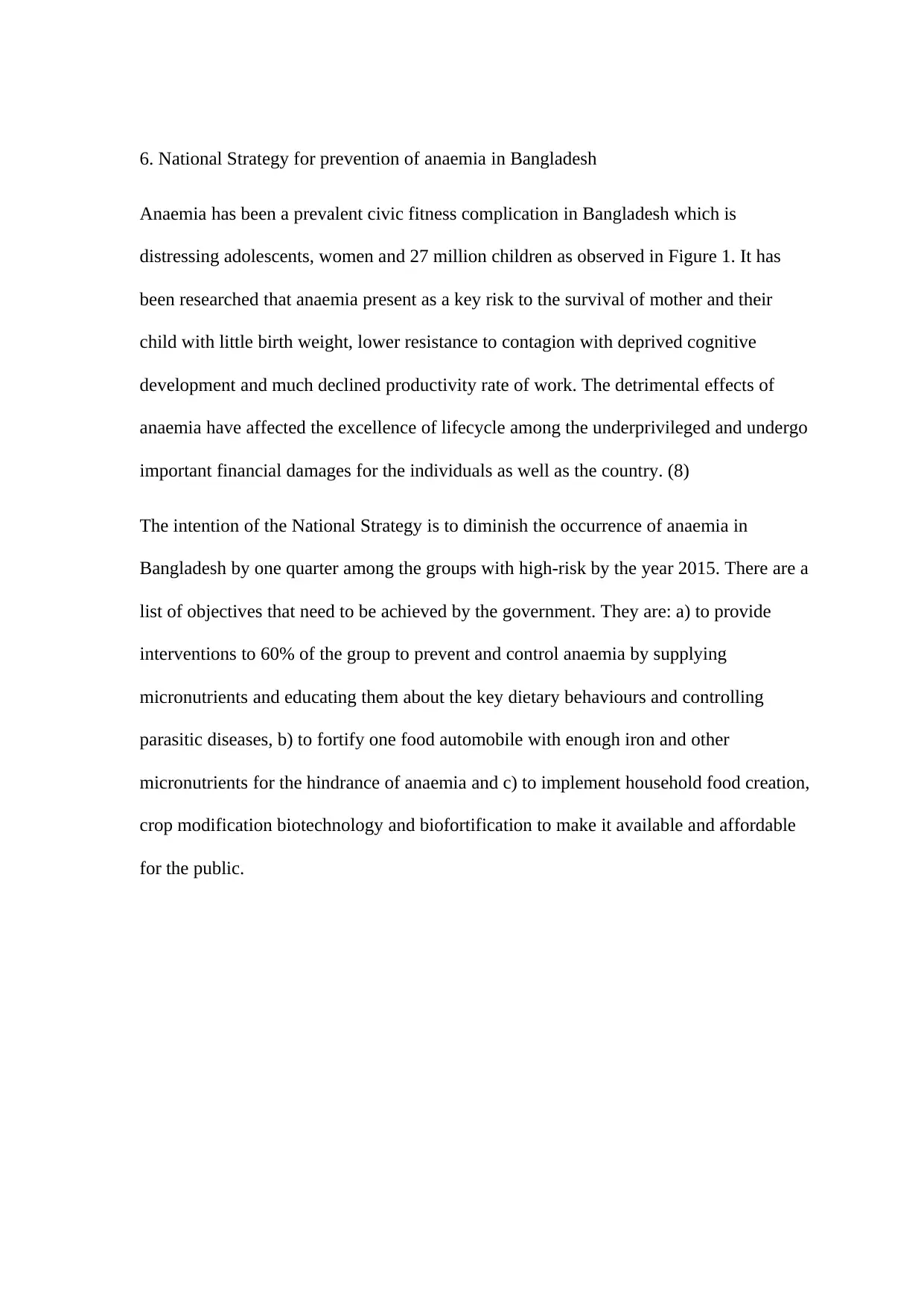
6. National Strategy for prevention of anaemia in Bangladesh
Anaemia has been a prevalent civic fitness complication in Bangladesh which is
distressing adolescents, women and 27 million children as observed in Figure 1. It has
been researched that anaemia present as a key risk to the survival of mother and their
child with little birth weight, lower resistance to contagion with deprived cognitive
development and much declined productivity rate of work. The detrimental effects of
anaemia have affected the excellence of lifecycle among the underprivileged and undergo
important financial damages for the individuals as well as the country. (8)
The intention of the National Strategy is to diminish the occurrence of anaemia in
Bangladesh by one quarter among the groups with high-risk by the year 2015. There are a
list of objectives that need to be achieved by the government. They are: a) to provide
interventions to 60% of the group to prevent and control anaemia by supplying
micronutrients and educating them about the key dietary behaviours and controlling
parasitic diseases, b) to fortify one food automobile with enough iron and other
micronutrients for the hindrance of anaemia and c) to implement household food creation,
crop modification biotechnology and biofortification to make it available and affordable
for the public.
Anaemia has been a prevalent civic fitness complication in Bangladesh which is
distressing adolescents, women and 27 million children as observed in Figure 1. It has
been researched that anaemia present as a key risk to the survival of mother and their
child with little birth weight, lower resistance to contagion with deprived cognitive
development and much declined productivity rate of work. The detrimental effects of
anaemia have affected the excellence of lifecycle among the underprivileged and undergo
important financial damages for the individuals as well as the country. (8)
The intention of the National Strategy is to diminish the occurrence of anaemia in
Bangladesh by one quarter among the groups with high-risk by the year 2015. There are a
list of objectives that need to be achieved by the government. They are: a) to provide
interventions to 60% of the group to prevent and control anaemia by supplying
micronutrients and educating them about the key dietary behaviours and controlling
parasitic diseases, b) to fortify one food automobile with enough iron and other
micronutrients for the hindrance of anaemia and c) to implement household food creation,
crop modification biotechnology and biofortification to make it available and affordable
for the public.
1 out of 7
Related Documents
Your All-in-One AI-Powered Toolkit for Academic Success.
+13062052269
info@desklib.com
Available 24*7 on WhatsApp / Email
![[object Object]](/_next/static/media/star-bottom.7253800d.svg)
Unlock your academic potential
Copyright © 2020–2025 A2Z Services. All Rights Reserved. Developed and managed by ZUCOL.




